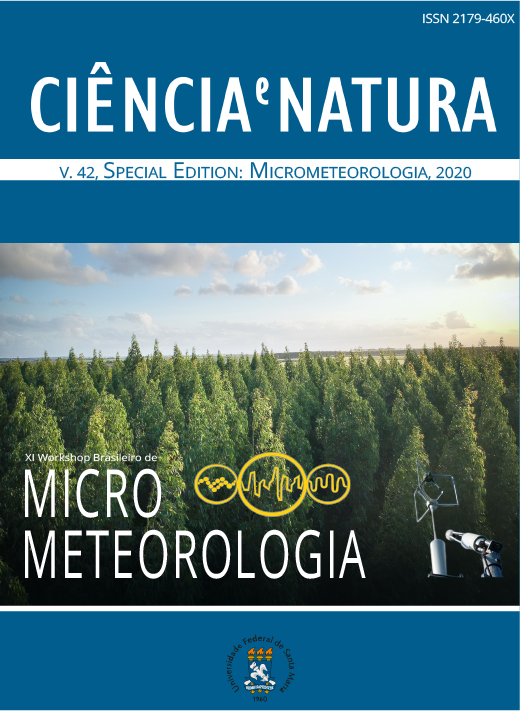Liquens como bioindicadores da poluição atmosférica em Paranaguá - PR
DOI:
https://doi.org/10.5902/2179460X46922Palavras-chave:
Bioindicadores, Porto, Liquens, Poluição AtmosféricaResumo
Os liquens são organismos amplamente utilizados como bioindicadores de qualidade do ar. Devido à sensibilidade desses organismos aos poluentes atmosféricos, em ambientes muito poluídos predominam-se as espécies mais resistentes ou até mesmo se extinguem. Neste trabalho, a concentração de liquens em árvores da cidade de Paranaguá foi avaliada para se comparar a qualidade do ar da região portuária e comercial com a qualidade do ar da região residencial da cidade. Foram avaliadas 90 árvores distribuídas pela cidade, onde se pode constatar que tanto a concentração de liquens quanto a variedade de espécies de liquens é maior na zona residencial do que na zona portuária, provavelmente devido à melhor qualidade do ar da zona residencial de Paranaguá.
Downloads
Referências
BRAZ, S. N.; LONGO, R. M. Bioindicadores de Poluição Ambiental: Um Estudo Bibliométrico. ANAP Brasil. v. 12, n. 17, p. 42 - 53, 2019.
BRITO, M. F. F.; GOMES, D. O. B.; SILVA, M. J. M. Biomonitoramento da qualidade do ar com tradescantia pallida como ferramenta no ensino de educação ambiental. Revista Ibero-Americana de Ciências Ambientais. v. 7, n. 1, p. 97 - 106, 2016.
CAÑÓN, E. R. P.; et al. LIQUENS COMO BIOINDICADORES DA POLUIÇÃO EM SÃO GABRIEL – RS. VII Salão Internacional de Ensino, Pesquisa e Extensão. Universidade Federal do Pampa. Anais do VII Salão Internacional de Ensino, Pesquisa e Extensão. Universidade Federal do Pampa, 2008, p. 1 - 2.
CARNEIRO, R. M. A. Bioindicadores vegetais de poluição atmosférica: uma contribuição para a saúde da comunidade. Dissertação (Mestrado em Enfermagem em Saúde Pública) – Universidade de São Paulo, São Paulo, 2004.
FUGA, A.; SAIKI, M.; MARCELLI, M. P. Análise de liquens por ativação neutrônica para estudo da poluição atmosférica da cidade de São Paulo. INAC. 2005.
GURGATZ, B. M. et al. Teloschistes flavicans (sw.) Norman como indicador de poluição atmosférica em Paranaguá – PR. RBCIAMB. n. 44, p. 27-39, 2017.
HERZIG, R. et al. Recalibration and validation of the Swiss lichen bioindication methods for air quality assessment. Environmental Science and Pollution Research, 2020.
KÄFFER, M. I.; MARTINS, S. M. A.; VARGAS, M. F. V. Biomonitoramento da qualidade do ar com uso de liquens na cidade de Porto Alegre, RS, Brasil. Fepam em revista, Porto Alegre, v. 6, n. 2, p. 4 - 12, 2012.
LEAL, L. L. et al. ESTUDO COMPARATIVO DE LIQUENS NA FATEC JUNDIAÍ E NA SERRA DO JAPÍ. In: 30° Congresso Nacional de Saneamento e Meio Ambiente, 2019 , São Paulo. Anais. Disponível em: http://evolvedoc.com.br/aesabesp/detalhes-3653_estudo-comparativo-de-liquens-na-fatec-jundiai-e-na-serra-do-japi. Acesso em: 25/05/2020.
SKYE, E. Lichens and Air Pollution. A study of cryptogamic epiphytes and environment in the Stockholm region. Almqvist and Wiksells Boktryckeri AB, Uppsala, Suécia, 1968.
SPIELMANN, A. A. FUNGOS LIQUENIZADOS (LIQUENS). Programa de Pós-Graduação em Biodiversidade Vegetal e Meio Ambiente, Instituto de Botânica - IBt, São Paulo, 2006.
VAN HALUWYN, C.; VAN HERK, C. M. Bioindication: The community approach. In: Nimis, P. L.; Scheidegger, C.; Wolseley, P. A. (Ed.). Monitoring with Lichens - Monitoring Lichens. Kluwer Academic Publishers Dordrecht, 2002, p. 39 - 64.
Downloads
Publicado
Como Citar
Edição
Seção
Licença
Para acessar a DECLARAÇÃO DE ORIGINALIDADE E EXCLUSIVIDADE E CESSÃO DE DIREITOS AUTORAIS clique aqui.
Diretrizes Éticas para Publicação de Revistas
A revista Ciência e Natura está empenhada em garantir a ética na publicação e na qualidade dos artigos.
A conformidade com padrões de comportamento ético é, portanto, esperada de todas as partes envolvidas: Autores, Editores e Revisores.
Em particular,
Autores: Os Autores devem apresentar uma discussão objetiva sobre a importância do trabalho de pesquisa, bem como detalhes e referências suficientes para permitir que outros reproduzam as experiências. Declarações fraudulentas ou intencionalmente incorretas constituem comportamento antiético e são inaceitáveis. Artigos de Revisão também devem ser objetivos, abrangentes e relatos precisos do estado da arte. Os Autores devem assegurar que seu trabalho é uma obra totalmente original, e se o trabalho e / ou palavras de outros têm sido utilizadas, isso tem sido devidamente reconhecido. O plágio em todas as suas formas constitui um comportamento publicitário não ético e é inaceitável. Submeter o mesmo manuscrito a mais de um jornal simultaneamente constitui um comportamento publicitário não ético e é inaceitável. Os Autores não devem submeter artigos que descrevam essencialmente a mesma pesquisa a mais de uma revista. O Autor correspondente deve garantir que haja um consenso total de todos os Co-autores na aprovação da versão final do artigo e sua submissão para publicação.
Editores: Os Editores devem avaliar manuscritos exclusivamente com base no seu mérito acadêmico. Um Editor não deve usar informações não publicadas na própria pesquisa do Editor sem o consentimento expresso por escrito do Autor. Os Editores devem tomar medidas de resposta razoável quando tiverem sido apresentadas queixas éticas relativas a um manuscrito submetido ou publicado.
Revisores: Todos os manuscritos recebidos para revisão devem ser tratados como documentos confidenciais. As informações ou ideias privilegiadas obtidas através da análise por pares devem ser mantidas confidenciais e não utilizadas para vantagens pessoais. As revisões devem ser conduzidas objetivamente e as observações devem ser formuladas claramente com argumentos de apoio, de modo que os Autores possam usá-los para melhorar o artigo. Qualquer Revisor selecionado que se sinta desqualificado para rever a pesquisa relatada em um manuscrito ou sabe que sua rápida revisão será impossível deve notificar o Editor e desculpar-se do processo de revisão. Os Revisores não devem considerar manuscritos nos quais tenham conflitos de interesse resultantes de relacionamentos ou conexões competitivas, colaborativas ou outras conexões com qualquer dos autores, empresas ou instituições conectadas aos documentos.






